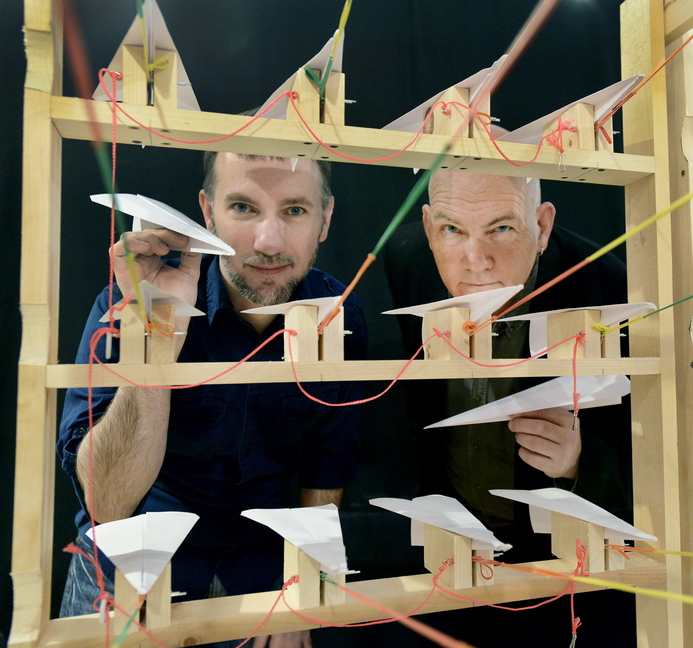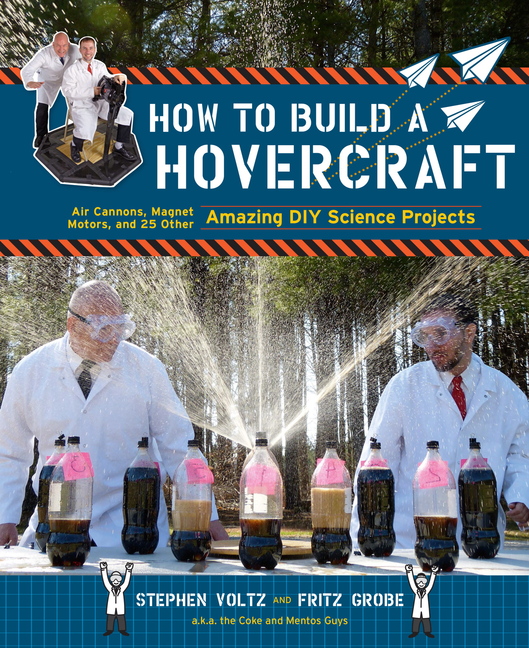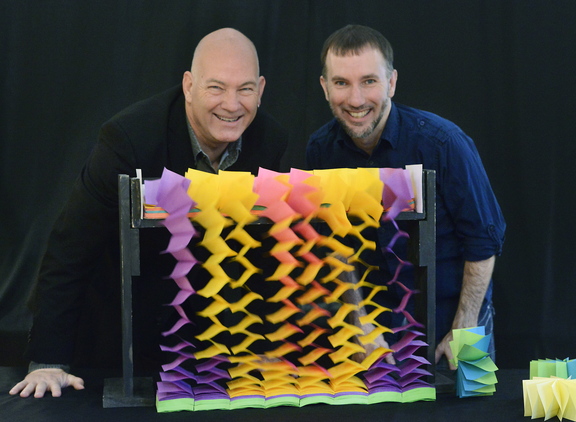BUCKFIELD — The launcher is fully loaded. Forty-eight paper airplanes, arranged in four rows of 12, are set to soar across the room.
Lab masters Fritz Grobe and Stephen Voltz and production supervisor Shane Miclon inspect the rubber bands-and-string launching mechanisms. They focus their cameras, adjust the lights.
When everything is ready to go, the three men stand back. Grobe winds the launching chord, and in seven seconds time 47 planes zoom in perfect arcs, crash into the far wall and flutter to the floor.
One gets stuck in the launching device, a rectangular framework made with 1-by-3s and dowels. That’s the one that will get all the attention when Grobe and Voltz examine video of the launch.
The Paper Airplane Squadron is the latest project for EepyBird Studios, a laboratory in the old North Buckfield Grange co-founded by Grobe and Voltz.
We know them better as the Coke and Mentos guys, whose viral videos of their backyard science experiment brought them widespread attention in print and broadcast media and made them a near-overnight sensation in online media. Their biggest video, “The Extreme Diet Coke and Mentos Experiments,” was seen by millions on its release in June 2006, and led to marketing opportunities, first with Coca-Cola and the makers of Mentos candies, and later McDonald’s, OfficeMax and other national brands.
Many observers, skeptical Mainers among them, assumed these two guys dressed in ties, white lab coats and goggles would enjoy their 15 minutes and move on. But Grobe, a 45-year-old former circus performer, and Voltz, 56, a trial lawyer with a lifelong love of street performing and clowning, have made their living off EepyBird, concocting joyful experiments that combine a Boy Scout’s curiosity with math-geek precision.
They’re out with a book, “How to Build a Hovercraft.” It includes 25 do-it-yourself home science projects. There’s a 10-plane version of the launcher in the book, along with a leaf-blower hovercraft that Grobe promises will lift you off the ground a good 2 inches and allow you to glide on air.
It’s child’s play, done well.
FROM SIMPLE TO WALKING ON AIR
There is a range of levels here, from simple projects that take 10 minutes to others that require work and know-how as well as visits to the Home Depot. But there’s a big pay-off: Walking on air, or building an air vortex pistol from a 5-gallon bucket.
“The reason I love the circus is that some days you do something you’ve never done before. The best days, you do things you never thought possible,” Grobe said. “Today, we launched 48 airplanes in 6 seconds. … That’s the heart of EepyBird. We do these outrageous stunts, but what really matters is that sense of accomplishment. That joy.”
“We’re not just buying the latest gadget and then we get bored with it and throw it away,” Voltz said. “This is about, ‘What can you make?’ ”
He calls “How to Build a Hovercraft” the book he always wanted as a kid, combining “really cool” projects with practical science.
Science is what makes the geysers go higher, Grobe noted.
The book was the result of prodding by Voltz’s brother, John.
John loved what Grobe and his brother were doing, and appreciated their success. They were masters of viral video, and hit at just the right time. In the middle of the first decade of the 21st century, broadband was reaching into homes across the country. Upstarts like YouTube, which depend on the reliability of broadband for effectiveness, took off. Social media helped spread the message.
EepyBird provided content.
Their Coke and Mentos experiments created fountains of exploding bottles of Coke, choreographed in spectacular, theatrical fashion. Voltz and Grobe got international play, performing their experiment on “The Late Show with David Letterman” and interviewing with the public radio program “All Things Considered.”
They’ve performed their experiments before audiences in New York, London, Paris, Istanbul. They’ve recreated the Ballagio fountains in Las Vegas.
They have won four Webby Awards and been nominated twice for Emmy Awards.
But John Voltz told them, “You have to stop hitting home runs with no one on base.”
Meaning, EepyBird made a lot of big splashes with its videos, but its existence was based on project-to-project success. The book offers a practical way to expand the business, John Voltz said.
“They do these big videos, and have to live off that whale until they kill another whale,” he said. “I asked them, ‘How can you get something more steady?’ ”
“How to Build a Hovercraft” is a result of that effort.
John Voltz lives in Cape Elizabeth now, but grew up in San Francisco. He put EepyBird in touch with Chronicle Books of San Francisco, which prides itself on publishing books about art and design and lifestyle.
Each experiment in the book has illustrations, instructions, photos and practical science lessons. QR codes lead readers to videos where Voltz and Grobe explain the experiments.
The experiments start on the second floor of the old Grange hall on the North Buckfield Road. It’s a big room, but feels very small. It’s crowded with stuff – PVC pipes, pieces of wood, juggling pins, exercise equipment and various experiments in one stage of development or another.
Once perfected, the experiments become videos starring Voltz and Grobe in lab coats and neckties. Companies use the videos to reach people who are turned off by and tune out mainstream media and advertising.
EepyBird’s 15 minutes of fame has stretched into seven and a half years.
THE COMMON DENOMINATOR
Voltz quit his job as an attorney, and Grobe set aside his career as a juggler and circus performer to make space for EepyBird.
Their backgrounds are different, but they connected at the Celebration Barn Theater in South Paris.
Voltz is from San Francisco, and spent a lot of time in his early years observing the city’s new vaudeville scene. He learned to juggle, and performed throughout high school and college.
He knew he could not make a living on the streets, and moved east to study law. He earned his degree from NYU Law, and spent 20 years a civil litigator, mostly in Massachusetts.
Voltz never gave up his interest in performance. He put it aside to make a living and to raise a family, but when he found himself at a point in his life where he had time, he came to South Paris to take an eccentric-performance workshop with Avner Eisenberg at the Celebration Barn.
He met Grobe there in 2000.
They shared a common interest not only in performance, but science. Both ask how and why things work, and both ask “Why not?” Instead of exploding one bottle of Coke, how about 100?
Their experiments start with a crazy idea. If it works, they see if they can do it 10 times. After that, they scale it up to 100. The airplanes are almost halfway there.
Grobe, a promising mathematician, started hanging out at the Barn as early as 1989.
He grew up in Brunswick, and went to Yale to study math. He was to become a mathematician like his parents. He came home for Christmas his freshman year and told his parents he wanted to juggle.
“He went to Yale determined to be math major,” said his mother, Betsey Grobe of Brunswick. “But he spent Christmastime on his knees in our living room learning to juggle five balls. He went back to Yale able to juggle five balls. He was very happy.”
He quit school and began a career in juggling and circus work.
Voltz and Grobe began EepyBird as a way to have fun and satisfy their mutual interest in performance and science. Neither expected it to turn into a career, but their success from the outset proved their timing was good.
The Coke-and-Mentos video hit in June 2006. Voltz took his last case that October. His legal smarts have served EepyBird well in their negotiations with companies for branding rights, but otherwise he has stpped away from his legal career.
Voltz splits his time between Maine and Massachusetts. Grobe, meanwhile, is fully committed to Buckfield, where EepyBird transforms ordinary objects into cool projects that involve practical, everyday science and translate well on the web.
Their videos have been seen more than 150 million times.
That’s a number that advertisers pay attention to, Voltz said.
“Every brand wants a viral video. Almost no one knows how to make them. But we do.”
Staff Writer Bob Keyes can be contacted at 791-6457 or at:
bkeyes@pressherald.com
Twitter: pphbkeyes
Send questions/comments to the editors.






Success. Please wait for the page to reload. If the page does not reload within 5 seconds, please refresh the page.
Enter your email and password to access comments.
Hi, to comment on stories you must . This profile is in addition to your subscription and website login.
Already have a commenting profile? .
Invalid username/password.
Please check your email to confirm and complete your registration.
Only subscribers are eligible to post comments. Please subscribe or login first for digital access. Here’s why.
Use the form below to reset your password. When you've submitted your account email, we will send an email with a reset code.